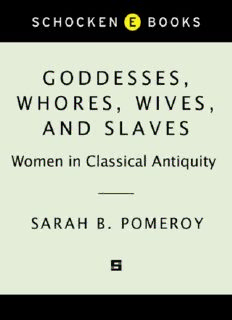
Goddesses, whores, wives, and slaves: women in classical antiquity PDF
Preview Goddesses, whores, wives, and slaves: women in classical antiquity
50 Years of Publishing 1945–1995 Copyright © 1975, 1995 by Sarah B. Pomeroy All rights reserved under International and Pan-American Copyright Conventions. Published in the United States by Schocken Books Inc., New York. Distributed by Pantheon Books, a division of Random House, Inc., New York. Library of Congress Cataloging-in-Publication Data Pomeroy, Sarah B. Goddesses, whores, wives, and slaves. Bibliography. 1. Women—History—To 500. 2. Greece—Social conditions. 3. Rome—Social conditions. I. Title. HQ1134.P64 301.41′2′0938 74-8782 eISBN: 978-0-30779147-4 v3.1 To Alexandra, who grew up with Goddesses CONTENTS Cover Title Page Copyright Dedication Chronological Table Preface Introduction I. Goddesses and Gods II. Women in the Bronze Age and Homeric Epic III. The Dark Age and the Archaic Period IV. Women and the City of Athens V. Private Life in Classical Athens VI. Images of Women in the Literature of Classical Athens VII. Hellenistic Women VIII. The Roman Matron of the Late Republic and Early Empire IX. Women of the Roman Lower Classes X. The Role of Women in the Religion of the Romans Epilogue: The Elusive Women of Classical Antiquity Notes Works Referred To Supplemental Bibliography Illustrations CHRONOLOGICAL TABLE (Many dates are approximate) PREFACE W Goddesses was published twenty years ago, I did not anticipate the HEN reception and long life that it would enjoy. As soon as the book appeared, it was described in Choice as “the first and only scholarly book on its subject in the English language.” It was widely reviewed in both the popular and the scholarly press. Goddesses was translated into Italian, German, and Spanish.1 Goddesses was published early in the development of the history of women in antiquity as a field for serious research, and it established parameters for subsequent studies of the history of women in antiquity. The overall chronological organization, which draws attention to change over time in women’s lives, has been preferred by most historians to the thematic or synchronic approach. The categorization by class and social status, which points to differences between wives on the one hand and whores and slaves on the other, and within social classes the additional comparisons by gender (for example, Ptolemaic queens and their brothers who are kings, and Roman matrons and upper-class Roman men), are in common use. The terms “respectable” and “nonrespectable” as applied to women have become clichés. The final important category, geographical variation, immediately observable in the distinctions between Greek women and Roman women, is nowadays axiomatic in women’s history and is gradually being recognized in family history.2 The constant attention to differences between women is nowadays a fundamental principle in women’s studies. The chronological organization, in particular, has made it easier to assimilate women’s history into traditional history. Since 1975 the study of women in antiquity has become part of the mainstream in the fields of classical studies and ancient history and many significant publications on Greek and Roman women have appeared. These include work on female artists and writers, women in Hellenistic Egypt, female sexuality, the economic contributions of women, pagan and Christian women in late antiquity, and female representation in literature and the visual arts. A sample of this work is given in the Supplemental Bibliography in the back of the present volume as well as in the notes to this Preface. This recent work uses traditional historiographical and art-historical approaches as well as the newer perspectives of feminist theory, literary theory, and gender studies.3 Although I considered revising Goddesses and discussed the matter with colleagues, I decided to retain the text of Goddesses as originally written. I have not changed my mind about any essential subject covered, though of course, I would present some of this material slightly differently today. As Heraclitus declared, “Everything is in process and nothing stays still,” and comparing existing things to the stream of a river, he says that “you would not step twice into the same river.”4 Nowadays I am even less willing to entertain the possibility of a prehistoric society in the Greek world in which women enjoyed a higher status than men, or were equal to them. If I were to rewrite my discussion of matriarchy I would emphasize its importance in Greek society and intellectual history as a myth. Of course, one woman who rules as queen may enjoy the highest status, but her position does not empower her female subjects. As later, well-documented historical periods show, a queen may rule in a patriarchal society. I was led to greater skepticism about prehistoric and Bronze Age matriarchy after investigating reports about Sir Arthur Evans’s excavations of the “Palace of Minos” at Cnossus, a site which has been referred to as a principal locus for a matriarchal society and for the predominance of mother- goddess cults.5 It became clear that Evans’s preconceptions about matriarchy and mother goddesses had led him to rearrange some of the archaeological evidence and alter his notebooks in order to corroborate his theories.6 Further study of Linear B tablets from Bronze Age sites in Crete and on the Greek mainland also gives no hint of vestiges of matriarchy. Rather the tablets show matrilineal naming of children who have mothers but no fathers. These mothers are probably slaves or women of subordinate status. The tablets show the same sexual division of labor that appears in later Greek society, where women engaged in
Description: